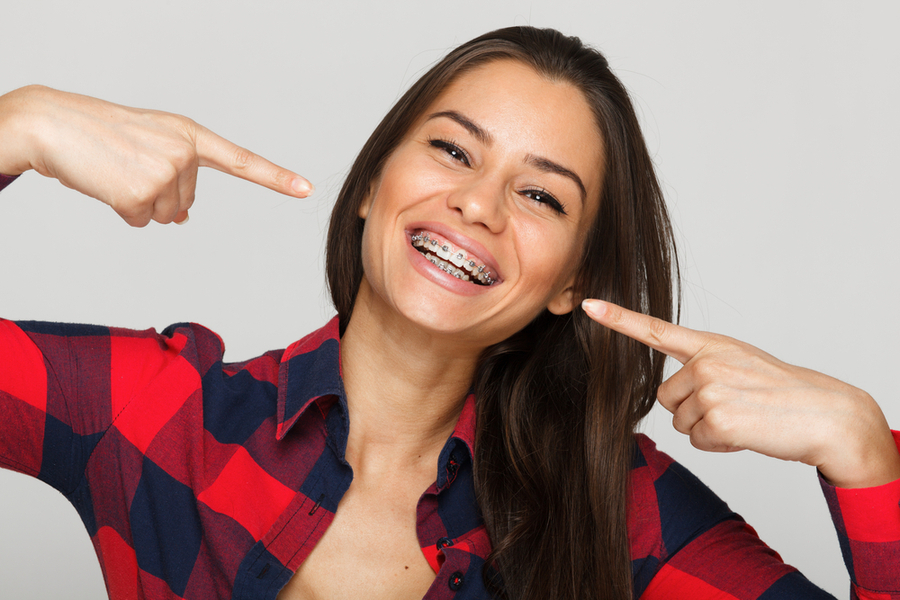
Happy 2019! Chances are you probably made a few New Year’s resolutions. Maybe you resolved to eat healthier, give back to the community or hit the gym five days a week, which are all great ideas. But what about your smile? Considering our oral health is tied to our overall health, it makes sense to show it some New Year’s resolution love, especially if you’re a braces or Invisalign patient. Not sure where to start? Well, I have you covered with resolution ideas for anyone in orthodontic treatment.
- Be diligent about brushing and flossing with braces AND Invisalign – Teeth move more effectively in a healthy oral environment, so it’s important to practice great oral hygiene to keep your teeth and gums in tip-top shape throughout your treatment. Not only that, if you get cavities when wearing braces, it can set back your treatment time. In severe cases, you may even need to have your braces removed while cavities are treated and then put back on at a later date.
Since brackets and wires tend to trap food and plaque, you’ll want to brush with braces in the morning, before bed and after meals and snacks. If you’re out and you don’t have your toothbrush on hand, rinse really well with water after snacking and brush when you get home. Floss with braces once daily using an orthodontic flosser or waxed dental floss threaded through a floss threader. Don’t forget to add a cavity-fighting mouthwash to the mix too. You may also find that an interproximal brush is helpful for getting in the tight spaces around your hardware.
If you use Invisalign instead of braces, you’re not off the hook! After investing in your smile, of course, you’ll want to make keeping it healthy a priority. To do that, always take your aligners out to eat and drink anything aside from water. Never drink sugary drinks with your aligners in because the sugar will just sit on the teeth. In addition to brushing in the morning and at night and flossing once daily, brush your teeth after meals before you put your aligners back in.
- Wear your appliances according to plan – The effectiveness of appliances, such as your Invisalign aligners, or any extras that go with your braces like rubber bands really depend on how well you stick to your treatment plan. Always wear them as directed to get the best results. We typically have our Alaska, Bothell, Monroe and Mill Creek Invisalign patients wear their aligners for about 22 hours per day. If you have rubber bands or another type of appliance with your braces, we’ll give you instructions for how often to wear those too.
- Keep up with your orthodontic appointments – Appointments are important because they let my team and I assess your treatment progress and make any necessary tweaks to ensure you finish on time and get the amazing results you deserve. If you’re wearing braces, you’ll have regular adjustments where we tighten your wires so that your teeth continue to shift into place. With Invisalign, while you don’t need adjustments, your occasional check-ups let us keep the process on track.
- Pass on sticky, hard or chewy foods if you’re wearing braces – When you start treatment, a team member will fill you in on exactly what not to eat with braces. In general, you should avoid really sticky, chewy or hard foods, including taffy, Starburst, nuts, pizza crust, popcorn, Doritos, whole raw apples or carrots, gum, Tootsie Rolls, licorice, corn on the cob (off the cob is A-Okay). They can damage your braces and they also get stuck between your brackets and wires. Honestly, giving up those few things will seem completely worth it when you see your fantastic new smile. If you’re having trouble sticking with this resolution, focus on all of the things you can still eat. After all, things like smoothies, mashed potatoes, and the occasional milkshake are great foods to eat with braces. One of the advantages of Invisalign is that you don’t have any food restrictions so you can continue to eat whatever you’d like. However, remember to take your aligners out before indulging.
- Befriend your Invisalign or Invisalign Teen case – There are a lot of advantages of Invisalign but the one thing that can be a challenge is keeping track of your aligners. You’ll get a case to store them in when they’re not in your mouth and it will simplify things if you make it a habit from the get-go to use it. Losing aligners is a hassle because you’ll need to come in for a replacement. Skipping ahead to the next set isn’t usually an option since each tray is programmed to achieve specific tooth movements.
- Visit your general dentist twice a year – Though dentists and orthodontists are both smile professionals, we specialize in different things. As an orthodontist, my focus is on correcting malocclusion, or issues with the spacing, positioning or size of the teeth and jaw. Your general dentist, on the other hand, takes a broad view of your oral health and screens for cavities, gum disease, and other problems. They also help in the prevention department and with professional cleanings, they’re able to remove hardened plaque that you can’t eliminate on your own with just a toothbrush. That’s why it’s essential to continue to see your dentist twice a year, or however often they recommend, for check-ups and cleanings throughout your orthodontic treatment.
- Protect your smile and appliance with a mouthguard – One of the best tips for having braces is to invest in a mouthguard as soon as you get your braces put on and wear it whenever you’re playing a sport or doing a physical activity where there is a risk of getting hit in the face. The brackets and wires can cut the soft tissues of your mouth and impact can damage your braces. However, even if you have Invisalign, a mouthguard is a key way to protect the new smile that’s developing. Only certain sports, such as football, field hockey, ice hockey, lacrosse and wrestling (when the wrestler is wearing braces), require mouthguards, yet basketball and baseball have some of the highest rates of orofacial injury and things like skateboarding can certainly result in a blow to the mouth. A mouthguard is super inexpensive in comparison to dealing with a dental injury and wearing one is such a simple measure to take to keep your mouth safe.
Consider adopting a few of these New Year’s resolutions for braces and Invisalign patients and your smile will thank you. If you haven’t started straightening your teeth yet and you’d like to make 2019 the year you get a smile you love, book a free consultation at Richard Chan Orthodontics today!
